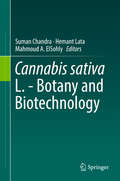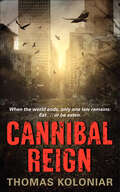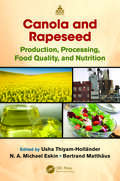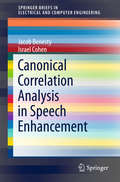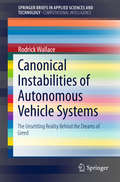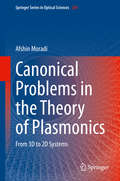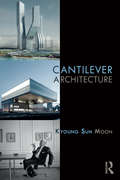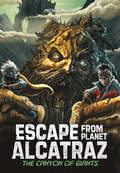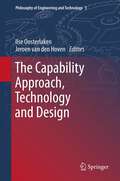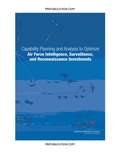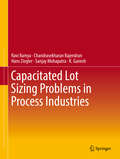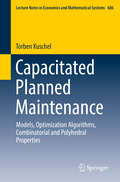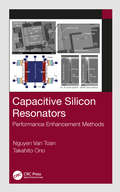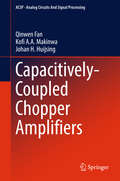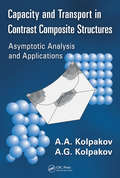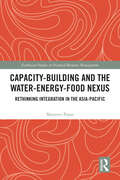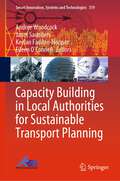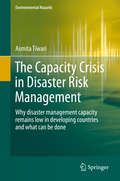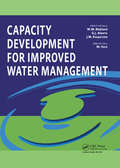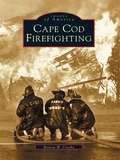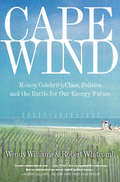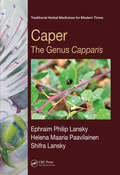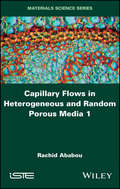- Table View
- List View
Cannabis sativa L. - Botany and Biotechnology
by Suman Chandra Hemant Lata Mahmoud A. ElsohlyThis book highlights current Cannabis research: its botany, authentication, biotechnology, in vitro propagation, chemistry, cannabinoids biosynthesis, metabolomics, genomics, biomass production, quality control, and pharmacology. Cannabis sativa L. (Family: Cannabaceae) is one of the oldest sources of fiber, food and medicine. This plant has been of interest to researchers, general public and media not only due to its medicinal properties but also the controversy surrounding its illicit use. Cannabis has a long history of medicinal use in the Middle East and Asia, being first introduced as a medicine in Western Europe in the early 19th century. Due to its numerous natural constituents, Cannabis is considered a chemically complex species. It contains a unique class of terpeno-phenolic compounds (cannabinoids or phytocannabinoids), which have been extensively studied since the discovery of the chemical structure of tetrahydrocannabinol (Δ9-THC), commonly known as THC, the main constituent responsible for the plant's psychoactive effects. An additionally important cannabinoid of current interest is Cannabidiol (CBD). There has been a significant interest in CBD and CBD oil (extract of CBD rich Cannabis) over the last few years because of its reported activity as an antiepileptic agent, particularly its potential use in the treatment of intractable epilepsy in children.
Cannibal Reign
by Thomas KoloniarA new star bursts onto the post-apocalyptic fiction scene: Thomas Koloniar. An epic dark saga set in a dystopian near-future, Cannibal Reign follows the fortunes of a small band of survivors, as they make their way across a nightmare landscape populated by bestial, flesh-eating savages after an asteroid strike destroys America. A dark, smart, action-packed vision of a terrifying possible tomorrow—when the only law left is “eat or be eaten”—Koloniar’s Cannibal Reign is an absolute must-read for fans of TV’s zombie smash hit The Walking Dead, Cormac McCarthy’s The Road, Lucifer’s Hammer, the Mad Max movies, and, of course, Stephen King’s immortal horror masterwork The Stand.
Canola and Rapeseed: Production, Processing, Food Quality, and Nutrition
by Usha Thiyam-Holländer N. A. Michael Eskin Bertrand MatthäusIn 2010, esteemed researchers gathered at a workshop held at the Richardson Centre for Functional Foods and Nutraceuticals at the University of Manitoba in Winnipeg, Canada. Drawn from these proceedings, Canola and Rapeseed: Production, Processing, Food Quality, and Nutrition presents state-of-the-art information on the chemistry of the minor const
Canonical Correlation Analysis in Speech Enhancement (SpringerBriefs in Electrical and Computer Engineering)
by Jacob Benesty Israel CohenThis book focuses on the application of canonical correlation analysis (CCA) to speech enhancement using the filtering approach. The authors explain how to derive different classes of time-domain and time-frequency-domain noise reduction filters, which are optimal from the CCA perspective for both single-channel and multichannel speech enhancement. Enhancement of noisy speech has been a challenging problem for many researchers over the past few decades and remains an active research area. Typically, speech enhancement algorithms operate in the short-time Fourier transform (STFT) domain, where the clean speech spectral coefficients are estimated using a multiplicative gain function. A filtering approach, which can be performed in the time domain or in the subband domain, obtains an estimate of the clean speech sample at every time instant or time-frequency bin by applying a filtering vector to the noisy speech vector. Compared to the multiplicative gain approach, the filtering approach more naturally takes into account the correlation of the speech signal in adjacent time frames. In this study, the authors pursue the filtering approach and show how to apply CCA to the speech enhancement problem. They also address the problem of adaptive beamforming from the CCA perspective, and show that the well-known Wiener and minimum variance distortionless response (MVDR) beamformers are particular cases of a general class of CCA-based adaptive beamformers.
Canonical Instabilities of Autonomous Vehicle Systems: The Unsettling Reality Behind the Dreams of Greed (SpringerBriefs in Applied Sciences and Technology)
by Rodrick WallaceThe asymptotic limit theorems of control and information theories make it possible to explore the dynamics of collapse likely to afflict large-scale systems of autonomous ground vehicles that communicate with each other and with an embedding intelligent roadway. Any vehicle/road system is inherently unstable in the control theory sense as a consequence of the basic irregularities of the traffic stream, the road network, and their interactions, placing it in the realm of the Data Rate Theorem that mandates a minimum necessary rate of control information for stability. It appears that large-scale V2V/V2I systems will experience correspondingly large-scale failures analogous to the vast, propagating fronts of power network blackouts, and possibly less benign but more subtle patterns of individual vehicle, platoon, and mesoscale dysfunction. The central matter is the synergism between poorly-understood traffic flow dynamics and similarly cryptic multisource information network dynamics, leading to highly punctuated phase transition analogs.
Canonical Problems in the Theory of Plasmonics: From 3D to 2D Systems (Springer Series in Optical Sciences #230)
by Afshin MoradiThis book provides a systemic and self-contained guide to the theoretical description of the fundamental properties of plasmonic waves. The field of plasmonics is built on the interaction of electromagnetic radiation and conduction electrons at metallic interfaces or in metallic nanostructures, and so to describe basic plasmonic behavior, boundary-value problems may be formulated and solved using electromagnetic wave theory based on Maxwell’s equations and the electrostatic approximation.In preparation, the book begins with the basics of electromagnetic and electrostatic theories, along with a review of the local and spatial nonlocal plasma model of an electron gas. This is followed by clear and detailed boundary value analysis of both classical three-dimensional and novel two-dimensional plasmonic systems in a range of different geometries. With only general electromagnetic theory as a prerequisite, this resulting volume will be a useful entry point to plasmonic theory for students, as well as a convenient reference work for researchers who want to see how the underlying models can be analysed rigorously.
Cantilever Architecture
by Kyoung Sun MoonCantilever Architecture shows you how to integrate cantilever designs into your building from conception, to help you create support-free structures without the need for columns or walls, whether for balconies, stairs, to occupy the air rights of the lot next door, or to build super tall buildings. The book includes 78 built case studies in 22 countries on 5 continents to illustrate various systems and their load carrying mechanisms at different scales. Includes an appendix on cantilevered furniture and more than 240 black and white images.
The Canyon of Giants (Escape from Planet Alcatraz)
by Michael DahlHoping to avoid the Alcatraz guards, Zak Nine and Erro decide to climb down into a deep canyon to hide. But soon the boys see some huge rock formations that move! Zak and Erro are quickly caught by the giant criminals that have been imprisoned in the deep gorge. Some of the giants want to hand the boys over to the Alcatraz guards to gain their own freedom. But a few giants would rather turn the boys into dinner! Will Zak and Erro outwit their captors and get away before becoming the giants' next meal?
Capabilities-Based Planning for Energy Security at Department of Defense Installations
by Constantine Samaras Henry H. WillisDepartment of Defense (DoD) installations rely on the commercial electricity grid for 99 percent of their electricity needs, but the U. S. electricity grid is vulnerable to disruption from natural hazards and actor-induced outages, such as physical or cyber attacks. Using portfolio analysis methods for assessing capability options, this paper presents a framework to evaluate choices among energy security strategies for DoD installations.
The Capability Approach, Technology and Design
by Jeroen Van Hoven Ilse OosterlakenThe capability approach of Martha Nussbaum and Amartya Sen places human capabilities at the centre stage of discussions about justice, equality, development and the quality of life. It rejects too much emphasis on mere preference satisfaction or resource provision and highlights the importance of human agency and freedom. This approach has already significantly influenced different fields of application, such as economics and development studies. Only recently have scholars started to explore its relevance for and application to the area of technology and design, which can be crucial factors in the expansion of human capabilities. How does technology influence human capabilities? What difference could a capability approach make to policies and practices of applying ICT in development processes in the South? How can we criticize and improve the design of technology from the perspective of the capability approach? The authors of this volume explore the implications of the capability approach for technology & design and together create the first volume on this emerging topic.
Capability Planning and Analysis to Optimize Air Force Intelligence, Surveillance, and Reconnaissance Investments
by National Research Council Committee on Examination of the Air Force Intelligence, Surveillance, and Reconnaissance (ISR) Capability Planning and Analysis (CPA&A) Process Division on Engineering and Physical Sciences Air Force Studies BoardIntelligence, surveillance, and reconnaissance (ISR) capabilities have expanded situation awareness for U.S. forces, provided for more precise combat effects, and enabled better decision making both during conflicts and in peacetime, and reliance on ISR capabilities is expected to increase in the future. ISR capabilities are critical to 3 of the 12 Service Core Functions of the U.S. Air Force: namely, Global Integrated ISR (GIISR) and the ISR components of Cyberspace Superiority and Space Superiority, and contribute to all others. In response to a request from the Air Force for ISR and the Deputy Assistant Secretary of the Air Force for Science, Technology, and Engineering, the National Research Council formed the Committee on Examination of the Air Force Intelligence, Surveillance, and Reconnaissance (ISR) Capability Planning and Analysis (CP&A) Process. In this report, the committee reviews the current approach to the Air Force corporate planning and programming process for ISR capability generation; examines carious analytical methods, processes, and models for large-scale, complex domains like ISR; and identifies the best practices for the Air Force. In Capability Planning and Analysis to Optimize Air Force Intelligence, Surveillance, and Reconnaissance Investments, the current approach is analyzed and the best practices for the Air Force corporate planning and programming processed for ISR are recommended. This report also recommends improvements and changes to existing analytical tools, methods, roles and responsibilities, and organization and management that would be required to ensure the Air Force corporate planning and programming process for ISR is successful in addressing all Joint, National, and Coalition partner's needs.
Capacitated Lot Sizing Problems in Process Industries
by Ravi Ramya Chandrasekharan Rajendran Hans Ziegler Sanjay Mohapatra K. GaneshThis book examines the Capacitated Lot Sizing Problem (CLSP) in process industries. In almost all process industries, there are situations where products have short/long setup times, and the setup of the product and its subsequent production are carried over, across consecutive periods. The setup of a product is carried over across more than one successive period in the case of products having long setup times. A product having short setup has its setup time less than the capacity of the period in which it is setup. The setup is immediately followed by its production of the product and it may also be carried over, across successive time period(s). Many process industries require production of a product to occur immediately after its setup (without the presence of idle time between the setup and production of the product), and they also require the product to be continuously produced without any interruption. This book considers a single-machine, single-level and multiple-item CLSP problem. This book introduces the Capacitated Lot Sizing Problem with Production Carryover and Setup Crossover across periods (CLSP-PCSC). Mathematical models are proposed which are all encompassing that they can handle continuous manufacturing (as in process industries), and also situations where the setup costs and holding costs are product dependent and time independent/time dependent, with possible backorders, and with other appropriate adaptations. Comprehensive heuristics are proposed based on these mathematical models to solve the CLSP-PCSC. The performance of the proposed models and heuristics are evaluated using problem instances of various sizes. This book also covers mathematical models developed for the Capacitated Lot Sizing Problem with Production Carryover and Setup Crossover across periods, and with Sequence-Dependent Setup Times and Setup Costs (CLSP-SD-PCSC). These models allow the presence of backorders and also address real-life situations present in process industries such as production of a product starting immediately after its setup and its uninterrupted production carryover across periods, along with the presence of short/long setup times. Heuristics proposed for the CLSP-PCSC can be extended to address the CLSP problem with sequence dependent setup costs and setup times. All the models and heuristics proposed in this book address some real-life considerations present in process industries.
Capacitated Planned Maintenance: Models, Optimization Algorithms, Combinatorial and Polyhedral Properties (Lecture Notes in Economics and Mathematical Systems #686)
by Torben KuschelThis book examines the problem of maintenance planning and scheduling in industrial production systems. It presents two practically relevant, deterministic mathematical models: the capacitated planned maintenance problem (CPMP) and the weighted uncapacitated planned maintenance problem (WUPMP). It introduces specific optimization algorithms such as construction heuristics, Lagrangean and tabu search metaheuristics. A problem independent hybrid approach links and alternates between two Lagrangean relaxations. It also analyzes the solvability with respect to the computational complexity of several problem classes, polyhedral properties and lower bounds. Computational studies demonstrate the performance of the heuristics, lower bounds, subgradients obtained from heuristics and the quality of dual information. This unique book includes implementation details and an introduction to the necessary theory making it suitable for upper undergraduate students.
Capacitive Silicon Resonators: Performance Enhancement Methods
by Takahito Ono Nguyen Van ToanMicrofabricated resonators play an essential role in a variety of applications, including mass sensing, timing reference applications, and filtering applications. Many transduction mechanisms including piezoelectric, piezoresistive, and capacitive mechanisms, have been studied to induce and detect the motion of resonators. This book is meant to introduce and suggest several technological approaches together with design considerations for performance enhancement of capacitive silicon resonators, and will be useful for those working in field of micro and nanotechnology. <P><P>Features <li>Introduces and suggests several technological approaches together with design considerations for performance enhancement of capacitive silicon resonators <li>Provides information on the various fabrication technologies and design considerations that can be employed to improve the performance capacitive silicon resonator which is one of the promising options to replace the quartz crystal resonator. <li>Discusses several technological approaches including hermetic packaging based on the LTCC substrate, deep reactive ion etching, neutral beam etching technology, and metal-assisted chemical etching, as well as design considerations for mechanically coupled, selective vibration of high-order mode, movable electrode structures, and piezoresistive heat engines were investigated to achieve small motional resistance, low insertion loss, and high quality factor. <li>Focuses on a capacitive sensing method based on the measurement of the change in capacitance between a sensing electrode and the resonant body. <li>Reviews recent progress in performance enhancement methods for capacitive silicon resonator, which are mainly based on the works of the authors.
Capacitively-Coupled Chopper Amplifiers (Analog Circuits and Signal Processing)
by Johan H. Huijsing Kofi A. A. Makinwa Qinwen FanThis book describes the concept and design of the capacitively-coupled chopper technique, which can be used in precision analog amplifiers. Readers will learn to design power-efficient amplifiers employing this technique, which can be powered by regular low supply voltage such as 2V and possibly having a +/-100V input common-mode voltage input. The authors provide both basic design concepts and detailed design examples, which cover the area of both operational and instrumentation amplifiers for multiple applications, particularly in power management and biomedical circuit designs.
Capacity and Transport in Contrast Composite Structures: Asymptotic Analysis and Applications
by A. A. Kolpakov A. G. KolpakovIs it possible to apply a network model to composites with conical inclusions?How does the energy pass through contrast composites? Devoted to the analysis of transport problems for systems of densely packed, high-contrast composite materials, Capacity and Transport in Contrast Composite Structures: Asymptotic Analysis and Applications an
Capacity-Building and the Water-Energy-Food Nexus: Rethinking Integration in the Asia-Pacific (Earthscan Studies in Natural Resource Management)
by Maureen PapasCritically analysing methodologies and objectives of capacity building and the practical linkages required to achieve the Sustainable Development Goals, this book looks at whether nexus thinking offers a systematic approach to combat global environmental problems and facilitate enhanced sustainable development. Building effective and sustainable mechanisms to tackle environmental problems requires in-depth understanding of relationships between natural resources, going beyond conventional policy and siloed decision making. The water energy food nexus has been promoted as a conceptual framework and management tool to facilitate integrated planning and practical linkages to support sustainable development. The author opens this book with an overview of capacity building and reviews the significance of the water energy food nexus, bringing in links to the 2030 Agenda. Climate change is highlighted as a key consideration in any conversation about natural resource use and case studies from Japan, India and China are utilised to show that whist long-term sustainable development practices are being implemented the environmental challenges across the region raise concerns about institutional capacity, economic sustainability and future of the region. Finally, through the lens of capacity building, the book suggests that whilst the water energy food nexus may provide a new approach to sustainable development, it will not be enough to achieve long-term sustainability or extend to the lives of those most affected. The book will be interest to scholars and students within the water, energy and agriculture sectors, sustainability governance and sustainable development. It will also be a valuable resource to those working in governmental organisations and NGOs involved in capacity building and development.
Capacity Building for the Planning, Assessment and Systematic Observations of Forests: With Special Reference to Tropical Countries (Environmental Science and Engineering)
by Karan Deo SinghThis book is intended to support the forestry institutions in the tropical countries in the planning, assessment and systematic observation of forests required to fulfill their obligations as laid in international conventions such as the CBD and UNFCCC. Following the Rio Conference, a number of countries, donors and international organizations have implemented capacity-building projects with varying degrees of success. One main reason for the varying success rates seems to lie in the design of technical assistance programs, which have been formulated on the traditional lines of mainly generating forest resources information or transferring technology; whereas Agenda 21 requires fundamental changes in countries' institutions and approaches to planning and implementing the conservation and sustainable development of forests through a process of continuing research and analysis. The book is intended to serve the basic needs of national planning strategies and international and donor support.
Capacity Building in Local Authorities for Sustainable Transport Planning (Smart Innovation, Systems and Technologies #319)
by Andree Woodcock Janet Saunders Keelan Fadden-Hopper Eileen O’ConnellThis book is conceptualized as being of interest to researchers in the field of sustainable transport, and also those who are working in the field. In the first case it will provide a reference on the state of the art of sustainable transport, and will also include insights into an EU project, how to go about delivering impact, how such projects effect local authorities, etc. Sustainable transport is an extreme growth area; it is highly innovative, with multi-million-pound investments transforming cities. The book will help and encourage resource poor small to medium local authorities catch up and meet their sustainability targets.
The Capacity Crisis in Disaster Risk Management
by Asmita TiwariHow can a place be built and managed so that it is safe for people to live? Ironically, many governments and citizens keep on asking the same question after every new disaster. Why, even with high levels of investment in increasing government's capacity to manage disasters, do the impacts of disasters continue to increase? What can the governments do differently? What is the role of local communities? Where should aid agencies invest? This book looks into these critical questions and highlights how current capacity development efforts might be resulting in the opposite--capacity crisis or capability trap. The book provides a new approach for the understanding and the developing of effective local capacity to reduce and manage future disaster impacts.
Capacity Development for Improved Water Management
by M.W. Blokland, G.J. Alaerts, J.M. Kaspersma and M. HareThis collection of papers explains how knowledge and capacity development can contribute to improved, effective water management with a digest of lessons learned in the areas of development of tools and techniques, field applications and evaluation. The authors are prominent practitioners, capacity builders and academics within the water and capacity development sectors.Capacity Development for Improved Water Management starts with an introduction and overview of progress and challenges in knowledge and capacity development in the water sector. The next part presents tools and techniques that are being used in knowledge and capacity development in response to the prevailing challenges in the water sector, and a review of experience with capacity change in other sectors. In the third part a number of cases are presented that cover knowledge and capacity development experiences in the water resources and water services sectors. This part also presents experiences on water education for children and on developing gender equity. The fourth part provides experiences with the monitoring and evaluation of knowledge and capacity building.
Cape Cod Firefighting (Images of America)
by Britton W. CrosbyFrom the founding of its first fire department in Provincetown in 1836, Cape Cod has had an exciting and unique firefighting history-as told in Cape Cod Firefighting. Rare and recently discovered photographs depict some of the area's largest fires, as well as its many innovations, from Provincetown's first Hunneman hand pumper, known as the "George Washington," to the brush breakers uniquely designed to respond to the Cape's devastating forest fires. Cape Cod fire departments also developed rescue squads that eventually evolved into the first emergency medical service system in Massachusetts to use paramedics. The images in Cape Cod Firefighting offer a tribute to the people and events that have shaped Cape Cod's fire rescue service.
Cape Wind: Money, Celebrity, Class, Politics, and the Battle for Our Energy Future on Nantucket Sound
by Robert WhitcombWhen Jim Gordon set out to build a wind farm off the coast of Cape Cod, he knew some people might object. <P><P>But there was a lot of merit in creating a privately funded, clean energy source for energy-starved New England, and he felt sure most people would recognize it eventually. Instead, all Hell broke loose. Gordon had unwittingly challenged the privileges of some of America's richest and most politically connected people, and they would fight him tooth and nail, no matter what it cost, and even when it made no sense. Cape Wind is a rollicking tale of democracy in action and plutocracy in the raw as played out among colorful and glamorous characters on one of our country's most historic and renowned pieces of coastline. As steeped in American history and local color as The Prince of Providence; as biting, revealing and fun as Philistines at the Hedgerow, it is also a cautionary tale about how money can hijack democracy while America lags behind the rest of the developed world in adopting clean energy.
Caper: The Genus Capparis (Traditional Herbal Medicines for Modern Times)
by Ephraim Philip Lansky Helena Maaria Paavilainen Shifra LanskyCaper: The Genus Capparis presents a pharmacognostic and ethnopharmacological exploration of the genus Capparis, emphasizing its medicinal potential. There is a long history of safe usage of Capparis parts both in diet and as plant drugs throughout the world, and the details of this usage are summarized in 39 tables covering numerous Capparis speci
Capillary Flows in Heterogeneous and Random Porous Media
by Rachid AbabouCapillary phenomena occur in both natural and human-made systems, from equilibria in the presence of solids (grains, walls, metal wires) to multiphase flows in heterogeneous and fractured porous media. This book, composed of two volumes, develops fluid mechanics approaches for two immiscible fluids (water/air or water/oil) in the presence of solids (tubes, joints, grains, porous media). Their hydrodynamics are typically dominated by capillarity and viscous dissipation. This first volume presents the basic concepts and investigates two-phase equilibria, before analyzing two-phase hydrodynamics in discrete and/or statistical systems (tubular pores, planar joints). It then studies flows in heterogeneous and stratified porous media, such as soils and rocks, based on Darcy’s law. This analysis includes unsaturated flow (Richards equation) and two-phase flow (Muskat equations). Overall, the two volumes contain basic physical concepts, theoretical analyses, field investigations and statistical and numerical approaches to capillary-driven equilibria and flows in heterogeneous systems
